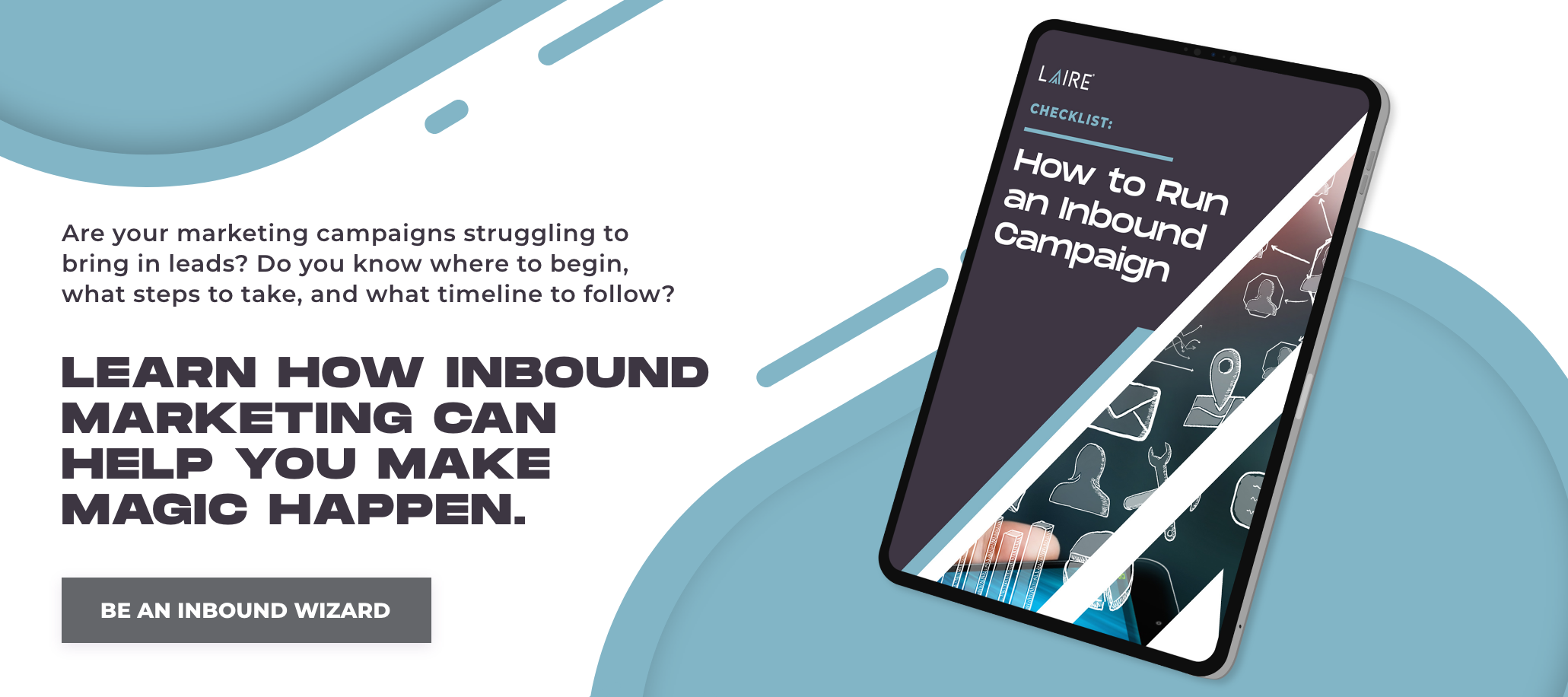Picture this - you take a bite of a peanut butter and jelly sandwich (a classic). As you're chewing, you realize there's no jelly - a sandwich tragedy. Expletives may be said, items may be thrown... Okay, that's a little extreme, but now it's just a peanut butter sandwich and missing an essential part of the delicious PB&J combination. The same goes for buyer personas and inbound marketing. Inbound marketing tactics are just a peanut butter sandwich without buyer personas.
All right, enough metaphors. Here's some real talk - B2B buyer personas should be a driving factor for your entire inbound marketing strategy. Understanding who your B2B buyer personas are, what motivates them, and so on will provide context for your efforts and make them more successful. But, to effectively accomplish this, you have to first know what a buyer persona is. So, let's define it!
What is a Buyer Persona?
A buyer persona is a semi-fictional representation of your ideal customer. We say "semi-fictional" because they are typically created based on actual customer data. So, even though your buyer personas aren't actually real people, they are still created from facts.
An awesome buyer persona should do the following:
- Accurately represent your ideal customer
- Be backed by research
- Get under the hood of your ideal customers' wants and motivations
- Not simply follow the different services/products your company offers
Let's explore that last bullet a little more closely. One of the most common mistakes people make when creating B2B buyer personas is to create them based on their company's services or products. For example, let's look at our business - a marketing agency. We offer services like social media marketing, content marketing, and website design.
But, our buyer personas aren't Social Media Sally, Content Marketing Connor, and Website Design Wesley. The reason is that we know our customers may want a combination of our services, so this buyer persona structure doesn't make sense.
So, how do you create awesome buyer personas? We've got the secret.
How to Create Top-Notch Buyer Personas
There are six overarching steps to successfully create a B2B buyer personas for your company. Although getting through all six steps will take some time, do not skip over any of them or you risk crafting some not-so-great buyer personas and not seeing the success you were hoping for from your inbound marketing efforts.
Here are the six steps:
- Step 1: Do your research
- Step 2: Identify common pain points
- Step 3: Identify your customers' motivations and goals
- Step 4: Determine how your company can help
- Step 5: Finalize your buyer personas with your team
- Step 6: Apply to your inbound marketing strategy
Step 1: Do your research
This step is probably the most important one of all. Without research, your buyer personas have very little chance of accurately representing your ideal customer. Step one is essentially made up of two parts - talking to your customers and discussing with your sales team.
Start off by creating a list of customers you want to talk to. We suggest around 15 to 20. Keep in mind - this list should not be a compilation of 15 to 20 of your best and happiest customers.
Instead, focus on including a mix of customers in your different lines of business or product lines, both brand-loyal fans and customers who have encountered issues in the past. This will give you a more accurate picture of your customer base.
Next, start scheduling persona interviews! Don't be discouraged if you don't hear back from all 20 customers. That's totally normal! But, if you don't get at least ten buyer persona interviews on the books, you may want to consider reaching out to a few more clients to fill those spots. Ten is really the minimum number of interviews in order to get enough information to build your B2B buyer personas.
In these interviews, you should ask questions, such as:
- What is your job role? What are your responsibilities?
- What challenges do you face in your role?
- How did you hear about our company?
- Did you research other solutions/companies?
- Why did you choose our company?
- Would you recommend us?
- What could we improve on?
As we stated above, along with these buyer persona interviews, you'll also want to talk to your sales team to go over your findings from your interviews and get input. Your sales team may help validate some of your gathered information and shed some light on specifics you may have questions on.
PRO TIP: As you're going through this research phase, pace yourself. This step is the most time-consuming, but it is absolutely crucial to successfully create awesome buyer personas!
Step 2: Identify common pain points
After conducting your buyer persona interviews and meeting with your sales team, you're ready to bring your findings together and find common ground in the challenges (or pain points) your customers are facing. No matter the industry, some customer pain points may include:
- Long or complicated buying process
- Hidden or unclear pricing
- Product/service doesn't meet their business' needs
- Inconsistent quality of product or service
- Lack of support for technical or service issues
Compile a list of all of the pain points you heard in the research phase and identify common pains. Knowing the challenges your customers face allows you to better understand their motivations and goals. And that brings us to the next step!
Step 3: Identify your customers' motivations and goals
Your customers' motivations and goals are what brought them to your company. They're searching for a solution to their pain or challenge and a way to achieve their goal. Their goals or motivations are what drives them. Some motivations could be:
- Free up their team to sell more, through more efficient internal processes
- Reduce costs, both in labor and operating expenses
- Realize increased revenue through improved productivity
- Reduce or remove frustrations, by partnering with a competent support team
Step 4: Determine how your company can help
Grab your list of customer pain points, goals, and motivations, and think about the solutions your company offers. How can you solve their challenges? Map each client pain point to one of your solutions - this can be helpful to truly map out visually on a whiteboard or a drawing tool.
This important step of aligning the solutions your company offers with your buyer personas' pain points is how you'll be able to convince people in your inbound efforts that your company is the best solution for them.
PRO TIP: Your ideal customers have a range of knowledge, from not understanding the industry lingo, to having highly technical knowledge. So be sure when you are preparing that list of relevant solutions for your unique buyer personas that you include words and language that speak to your clients' level of knowledge.
Step 5: Finalize your buyer personas with your team
At this point, you've done your research and explored your findings. Now it's time to bring that information together and craft your buyer personas. This is great to do as a group with your team, so everyone can get on the same page, understand your customers, and know who you're targeting as a company moving forward.
There really isn't a magic number for how many buyer personas you should create. It ultimately depends on your specific business and customer base and the commonalities you found in your buyer persona research. You may have two buyer personas, or you may have five.
At LAIRE, we've identified three buyer personas based on job titles and common pains. We have:
- Owner/CEO Owner - Head of a company who wants to grow the business through marketing but the department is nonexistant, or stretched too thin and needs help.
- Marketing Manager Molly - VP or manager in a marketing department who is juggling too many roles and needs help with the company's digital efforts.
- Facilitator Fran - the office manager or contact for a company that does not have a marketing department, who is juggling admin roles and marketing is not their focus.
The buyer personas you establish for your company may not be based on job titles. You have to make your buyer personas unique to your business.
When crafting your buyer personas you should make sure to include the following:
- Demographic information
- Their role and responsibilities
- Goals
- Psychographics
Once you've created your buyer personas and your whole team is on board, it's time to apply them to your inbound marketing tactics, which brings us to the final step!
Step 6: Apply to your inbound marketing strategy
Your buyer personas should influence everything in your inbound marketing strategy - and we mean everything!
- Website messaging
- Social media posts
- Blogging
- Content offers
- Video marketing
The list goes on and on. Your inbound marketing tactics should all address and try to help your buyer personas solve their pain points. It's all about helping, not just selling! After all, if your ideal customer sees value in your company and the solutions you offer, they are more likely to convert.
You've got your steps, now go create awesome buyer personas
With these six steps, you now have all the secrets you need to craft accurate B2B buyer personas for your company. And if you implement them correctly, you will definitely see a better ROI for your inbound marketing efforts. Now, go forth and schedule some buyer persona interviews!
You now know that buyer personas are a necessity for any successful inbound marketing strategy. Looking for even more tips? See where you could improve your current efforts with your free copy of our inbound marketing checklist!


